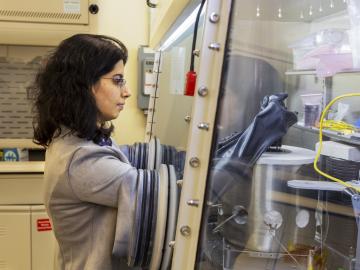Filter News
Area of Research
- Advanced Manufacturing (12)
- Biology and Environment (29)
- Clean Energy (89)
- Climate and Environmental Systems (2)
- Computational Engineering (1)
- Computer Science (3)
- Electricity and Smart Grid (1)
- Fusion and Fission (7)
- Fusion Energy (3)
- Isotopes (1)
- Materials (47)
- Materials for Computing (18)
- Mathematics (1)
- National Security (4)
- Neutron Science (21)
- Nuclear Science and Technology (10)
- Nuclear Systems Modeling, Simulation and Validation (1)
- Quantum information Science (2)
- Sensors and Controls (1)
- Supercomputing (22)
News Topics
- (-) 3-D Printing/Advanced Manufacturing (55)
- (-) Advanced Reactors (16)
- (-) Bioenergy (27)
- (-) Climate Change (21)
- (-) Grid (18)
- (-) Materials (34)
- (-) Materials Science (61)
- (-) Mercury (5)
- (-) Nanotechnology (27)
- Artificial Intelligence (16)
- Big Data (18)
- Biology (29)
- Biomedical (31)
- Biotechnology (7)
- Buildings (14)
- Chemical Sciences (12)
- Clean Water (10)
- Composites (8)
- Computer Science (75)
- Coronavirus (33)
- Critical Materials (6)
- Cybersecurity (11)
- Decarbonization (8)
- Energy Storage (44)
- Environment (72)
- Exascale Computing (6)
- Frontier (5)
- Fusion (22)
- High-Performance Computing (22)
- Isotopes (20)
- ITER (4)
- Machine Learning (9)
- Mathematics (3)
- Microscopy (19)
- Molten Salt (2)
- National Security (9)
- Net Zero (1)
- Neutron Science (50)
- Nuclear Energy (37)
- Physics (18)
- Polymers (12)
- Quantum Computing (5)
- Quantum Science (26)
- Security (6)
- Space Exploration (6)
- Statistics (1)
- Summit (26)
- Sustainable Energy (59)
- Transformational Challenge Reactor (5)
- Transportation (38)
Media Contacts

The world is full of “huge, gnarly problems,” as ORNL research scientist and musician Melissa Allen-Dumas puts it — no matter what line of work you’re in. That was certainly the case when she would wrestle with a tough piece of music.

Biologist Larry York’s fascination with plant roots has spurred his research across four continents and inspired him to create accessible tools that enable others to explore the underground world.

ORNL and Tuskegee University have formed a partnership to develop new biodegradable materials for use in buildings, transportation and biomedical applications.

An analysis by Oak Ridge National Laboratory shows that using less-profitable farmland to grow bioenergy crops such as switchgrass could fuel not only clean energy, but also gains in biodiversity.

A discovery by Oak Ridge National Laboratory researchers may aid the design of materials that better manage heat.

Oak Ridge National Laboratory researchers determined that designing polymers specifically with upcycling in mind could reduce future plastic waste considerably and facilitate a circular economy where the material is used repeatedly.

A new technology for rare-earth elements chemical separation has been licensed to Marshallton Research Laboratories, a North Carolina-based manufacturer of organic chemicals for a range of industries.

Researchers at the Department of Energy’s Oak Ridge, Brookhaven and Idaho national laboratories and Stony Brook University have developed a novel approach to gain fundamental insights into molten salts, a heat transfer medium important to advanced

Energy Secretary Jennifer Granholm visited ORNL on Nov. 22 for a two-hour tour, meeting top scientists and engineers as they highlighted projects and world-leading capabilities that address some of the country’s most complex research and technical challenges.

Ten scientists from the Department of Energy’s Oak Ridge National Laboratory are among the world’s most highly cited researchers, according to a bibliometric analysis conducted by the scientific publication analytics firm Clarivate.




